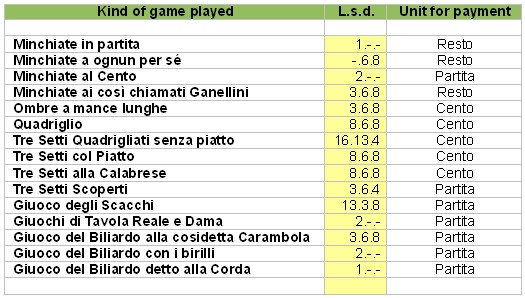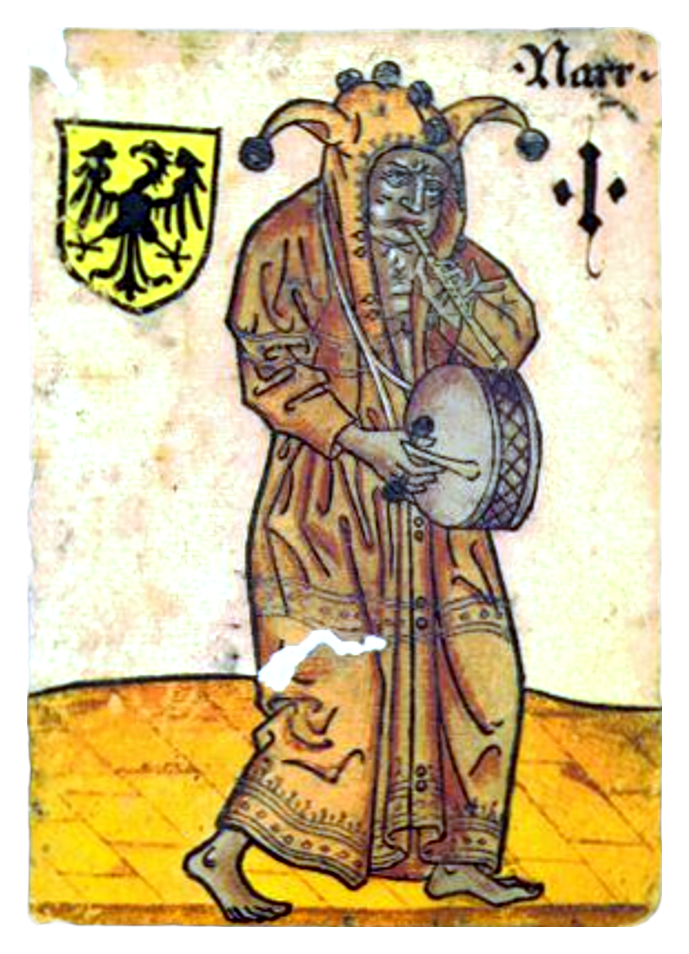Progress in Tarot History Research
In c. 2003 the perspective of Tarot origin research could be described with the following graphic:
Black and red points stood for documents, which contained the word "Trionfi" or similar in relation to playing card notes. Black stood for "document from Ferrara" and red stood for "document from elsewhere".
The numbers indicated the years 1442-1465. The whole had been mainly based on the text "The Prince and the Playing Cards" (1996) published by Gerardo Ortalli based to great parts on the researches of Adriano Franceschini, which had been then a great improvement against the earlier works of Dummett and Stuart Kaplan, which had been of great value for the increasing English discussion of Tarot History.
A recent attempt to produce a similar graphic for the research state of 2013 gives a new picture. I've to excuse, that it might contain still errors and also it contains some critical documents, which are interpreted by some as Trionfi documents, but not by others. And the counting system against the presentation attempt of 2003 has changed a little bit.
Beside these weak points there is naturally the good side effect, that one gets a global impression, how much has happened in the meantime.
Considered are the years 1440-1465. The final number of each row gives the number of documents to the connected years.
The table uses colors and the colors have meaning. The meaning is explained by this table:
The colors lead to specific developments in the researcher time, and indicate the articles, by which the entries became known in the Tarot History researcher world.
For "dark grey" and "before 2003" we've mostly the already mentioned "The Prince and the Playing Cards. For light grey we've the time, when Trionfi.com had started and organized a collection of the documents. The improvements of the lists were rare events till Franco Pratesi started to become again engaged in Playing Card History. This happened in November 2011 in context of the detection of a new Arnold Esch report in 2007, who had noted some Trionfi card documents in a custom register in Rome.
Franco made then his own researches in Florence and detected all the documents, which are indicated in green and yellow.
Dark green: Filippo di Marco productions (13 new documents; December 2011)
Strong yellow: Silk dealer sell decks (4 new documents; March 2012)
http://trionfi.com/naibi-silk-dealers
Light yellow: Silk dealer acquire decks (37 documents; April 2012)
http://trionfi.com/naibi-aquired
Light green: All other detections
Satutes Asinalunga and Gambassi (2 documents; April 2012)
http://trionfi.com/trionfi-siena
Lapini family report (5 documents)
http://trionfi.com/lapini-playing-cards
Cambini export
http://trionfi.com/cambino-trade-venice (1 document; August 2012)
Bandini deck (1 document; September 2012)
http://trionfi.com/notary-ser-giovanni-bandini
This had been really a great time. The number of documents had been increased by c. 200 % then. The attention in research, mostly used to focus on Milan, Ferrara and Bologna, had turned to Florence.
Dark blue: Additionally to Franco Pratesi's successes Thierry Depaulis had detected a Trionfi card note in a work of Nerida Newbigin about the diaries of Giusto Giusti. This was from September 1440, the deck was from Florence and the note became the new "oldest appearance" of the word Trionfi in playing card context. Franco wrote a report:
http://trionfi.com/giusto-giusti
Light blue: Prof. Dr. Arnold Esch, not a playing card researcher, but for some time responsible for a custom register in Rome, had observed, how much excitement a few remarks about playing card imports to Rome had caused on our web page. So his plan was born to take a second view especially for items of our interest. The result became a 13-pages article, written together with Doris Esch, which was published in the Gutenberg Jahrbuch 2013. With this the number of known Trionfi documents was more than doubled again.
A webpage in preparation:
http://trionfi.com/arnold-esch-playing-card-reports
... for the moment it's not much there, but it likely will develop soon. Esch's impact on our presentation of the early Trionfi card document can be also seen here:
http://trionfi.com/et94















